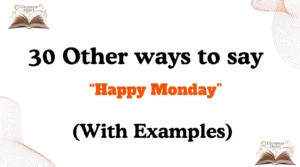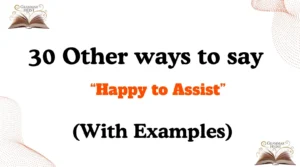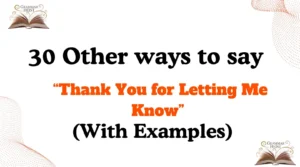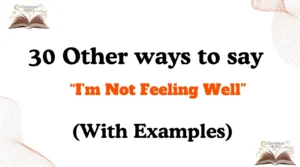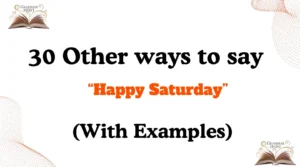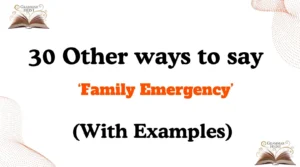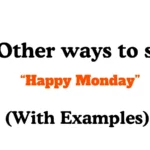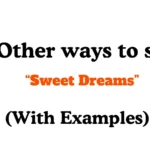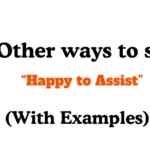Sometimes, the simplest questions hold the most weight. Asking “Are you free?” is a small phrase, yet it carries meaning beyond availability—it shows care, respect for time, and the desire to connect. But sometimes, the directness of the phrase can feel too casual, repetitive, or even impersonal. That’s where finding thoughtful alternatives comes in.
Below, you’ll discover 30 different ways to ask if someone is available, complete with scenarios, tones, examples, and explanations to help you choose the right words for the right moment.
What Does “Are You Free” Mean?
The phrase “Are you free” is a polite, straightforward way of asking if someone is available to talk, meet, or engage in an activity. It focuses on checking availability without demanding commitment.
Is It Professional/Polite to Say “Are You Free”?
Yes, “Are you free” is both polite and acceptable, especially in casual settings. However, in professional contexts, it can sometimes sound too direct or vague. That’s why using alternatives—like “Do you have a moment?” or “Would this time work for you?”—can feel more considerate and professional.
Pros or Cons of Saying “Are You Free”
Pros:
- Quick and easy to understand
- Polite without being overly formal
- Works well in casual settings
Cons:
- Can feel too blunt in professional situations
- May come across as intrusive if the context isn’t clear
- Lacks warmth compared to more thoughtful alternatives
Synonyms For “Are You Free”
- Do you have a moment?
- Can we talk for a bit?
- Are you available right now?
- Would now be a good time?
- Do you have time later?
- When would be a good time for you?
- Could I grab a few minutes of your time?
- Is this a good time to talk?
- Mind if I check in?
- Could we connect for a moment?
- Can we catch up quickly?
- Are you around?
- Do you have a second?
- Would you mind a quick chat?
- Is this a good moment?
- Can I have a bit of your time?
- Do you have a chance to talk?
- Would you be open to a quick call?
- Can I run something by you?
- Free to connect?
- Could we speak briefly?
- Are you good to talk?
- Is now a convenient time?
- Can we go over this together?
- Do you have space in your schedule?
- Would later today work for you?
- Can I borrow a few minutes?
- Do you have bandwidth right now?
- Could we touch base?
- Would you mind if I asked for a moment?
1. Do you have a moment?
Scenario: When you want to politely ask for someone’s attention without overwhelming them.
Examples:
- “Hey, do you have a moment to go over these notes?”
- “Do you have a moment to chat about tomorrow’s meeting?”
- “Do you have a moment for a quick call?”
Tone: Polite, professional, considerate. Explanation: This phrase respects time and is often used in workplaces.
2. Can we talk for a bit?
Scenario: When you want to start a personal or professional conversation.
Examples:
- “Can we talk for a bit after lunch?”
- “I was hoping to catch up—can we talk for a bit?”
- “Can we talk for a bit about your project update?”
Tone: Friendly, approachable. Explanation: Invites dialogue without pressure.
3. Are you available right now?
Scenario: When checking someone’s current availability.
Examples:
- “Are you available right now for a quick question?”
- “Are you available right now, or should I check later?”
- “Are you available right now for a short chat?”
Tone: Direct, clear, polite. Explanation: Gets to the point quickly while staying respectful.
4. Would now be a good time?
Scenario: When you want to avoid interrupting or burdening someone.
Examples:
- “Would now be a good time to review this?”
- “Would now be a good time to discuss next steps?”
- “Would now be a good time for a quick update?”
Tone: Respectful, thoughtful. Explanation: A gentle, professional phrasing.
5. Do you have time later?
Scenario: When planning ahead instead of asking immediately.
Examples:
- “Do you have time later for a short call?”
- “Do you have time later this afternoon to connect?”
- “Do you have time later in the week to review together?”
Tone: Polite, forward-thinking. Explanation: Shows flexibility and consideration.
6. When would be a good time for you?
Scenario: When scheduling in advance.
Examples:
- “When would be a good time for you to meet?”
- “I’d like to catch up—when would be a good time for you?”
- “When would be a good time for you to share your thoughts?”
Tone: Accommodating, respectful. Explanation: Hands control to the other person.
7. Could I grab a few minutes of your time?
Scenario: When asking in a respectful, professional tone.
Examples:
- “Could I grab a few minutes of your time to explain this?”
- “Could I grab a few minutes of your time for feedback?”
- “Could I grab a few minutes of your time to clarify something?”
Tone: Professional, courteous. Explanation: A polished way of seeking attention.
8. Is this a good time to talk?
Scenario: Before starting a deeper discussion.
Examples:
- “Is this a good time to talk about the changes?”
- “Is this a good time to talk, or should I check later?”
- “Is this a good time to talk through your ideas?”
Tone: Respectful, flexible. Explanation: Avoids being intrusive.
9. Mind if I check in?
Scenario: When reaching out casually yet politely.
Examples:
- “Mind if I check in on how things are going?”
- “Mind if I check in with you later today?”
- “Mind if I check in about the project status?”
Tone: Friendly, light, casual. Explanation: Works well in informal but respectful conversations.
10. Could we connect for a moment?
Scenario: When asking to link up personally or professionally.
Examples:
- “Could we connect for a moment about tomorrow’s plan?”
- “Could we connect for a moment after your call?”
- “Could we connect for a moment to clear things up?”
Tone: Warm, professional. Explanation: Creates a sense of collaboration.
11. Can we catch up quickly?
Scenario: When you want a light, casual way to reconnect.
Examples:
- “Hey, can we catch up quickly before you head out?”
- “Can we catch up quickly on how things went today?”
- “Can we catch up quickly after the meeting?”
Tone: Friendly, warm. Explanation: Works well with friends or colleagues in informal contexts.
12. Are you around?
Scenario: Casual check to see if someone is available nearby.
Examples:
- “Are you around this afternoon to meet?”
- “Hey, are you around to talk?”
- “Are you around for a call in a bit?”
Tone: Informal, approachable. Explanation: Great for texting or casual chats.
13. Do you have a second?
Scenario: For quick, low-demand requests.
Examples:
- “Do you have a second to sign this?”
- “Do you have a second to chat?”
- “Do you have a second for a quick question?”
Tone: Respectful yet concise. Explanation: Perfect when you need something fast.
14. Would you mind a quick chat?
Scenario: When you want to sound extra polite.
Examples:
- “Would you mind a quick chat about this?”
- “Would you mind a quick chat later today?”
- “Would you mind a quick chat before you go?”
Tone: Thoughtful, polite. Explanation: Gentle phrasing that respects boundaries.
15. Is this a good moment?
Scenario: Checking availability in a considerate way.
Examples:
- “Is this a good moment to go over details?”
- “Is this a good moment for a call?”
- “Is this a good moment to share feedback?”
Tone: Warm, respectful. Explanation: A softer way of asking “are you free right now.”
16. Can I have a bit of your time?
Scenario: When you want to ask with sincerity.
Examples:
- “Can I have a bit of your time this afternoon?”
- “Can I have a bit of your time to clarify something?”
- “Can I have a bit of your time before you leave?”
Tone: Considerate, professional. Explanation: Polite and slightly formal, good for work settings.
17. Do you have a chance to talk?
Scenario: When looking for flexibility.
Examples:
- “Do you have a chance to talk later?”
- “Do you have a chance to talk this week?”
- “Do you have a chance to talk about your concerns?”
Tone: Gentle, approachable. Explanation: Emphasizes convenience for the other person.
18. Would you be open to a quick call?
Scenario: Asking permission in a warm way.
Examples:
- “Would you be open to a quick call later today?”
- “Would you be open to a quick call this week?”
- “Would you be open to a quick call tomorrow morning?”
Tone: Polite, considerate. Explanation: Adds choice, making it less demanding.
19. Can I run something by you?
Scenario: When you need feedback or advice.
Examples:
- “Can I run something by you when you’re free?”
- “Can I run something by you this afternoon?”
- “Can I run something by you quickly?”
Tone: Respectful, collaborative. Explanation: Shows you value their input.
20. Free to connect?
Scenario: Casual, short-form check-in.
Examples:
- “Free to connect right now?”
- “Hey, free to connect later today?”
- “Free to connect for a quick call?”
Tone: Casual, modern. Explanation: Simple and quick, ideal for text or chat.
21. Could we speak briefly?
Scenario: When you want professional and concise phrasing.
Examples:
- “Could we speak briefly after your call?”
- “Could we speak briefly about your report?”
- “Could we speak briefly today?”
Tone: Professional, polite. Explanation: Best for formal or business contexts.
22. Are you good to talk?
Scenario: A relaxed way of checking in.
Examples:
- “Are you good to talk now?”
- “Are you good to talk after your break?”
- “Are you good to talk later today?”
Tone: Friendly, casual. Explanation: Works well with colleagues or friends.
23. Is now a convenient time?
Scenario: Polite way to ensure you’re not interrupting.
Examples:
- “Is now a convenient time to discuss the project?”
- “Is now a convenient time for a quick call?”
- “Is now a convenient time to go over this?”
Tone: Considerate, formal. Explanation: Shows respect for the other’s schedule.
24. Can we go over this together?
Scenario: When suggesting collaboration.
Examples:
- “Can we go over this together later today?”
- “Can we go over this together quickly?”
- “Can we go over this together tomorrow?”
Tone: Collaborative, friendly. Explanation: Invites teamwork instead of demanding time.
25. Do you have space in your schedule?
Scenario: For planned discussions or meetings.
Examples:
- “Do you have space in your schedule next week?”
- “Do you have space in your schedule for a quick meeting?”
- “Do you have space in your schedule today?”
Tone: Formal, thoughtful. Explanation: Great for professional planning.
26. Would later today work for you?
Scenario: Offering a specific but flexible option.
Examples:
- “Would later today work for you to connect?”
- “Would later today work for you for a quick review?”
- “Would later today work for you to chat?”
Tone: Flexible, respectful. Explanation: Balances suggestion with politeness.
27. Can I borrow a few minutes?
Scenario: Light and respectful way to ask.
Examples:
- “Can I borrow a few minutes of your time?”
- “Can I borrow a few minutes after lunch?”
- “Can I borrow a few minutes before you leave?”
Tone: Polite, thoughtful. Explanation: Friendly metaphor that softens the request.
28. Do you have bandwidth right now?
Scenario: Modern phrase, often used in workplace contexts.
Examples:
- “Do you have bandwidth right now for a quick task?”
- “Do you have bandwidth right now to chat?”
- “Do you have bandwidth right now to review this?”
Tone: Professional, current. Explanation: Uses workplace language, showing awareness of workload.
29. Could we touch base?
Scenario: Often used in professional settings to reconnect.
Examples:
- “Could we touch base this afternoon?”
- “Could we touch base about the project?”
- “Could we touch base quickly before the meeting?”
Tone: Professional, collaborative. Explanation: A polished way to ask for connection.
30. Would you mind if I asked for a moment?
Scenario: Extra-polite phrasing, perfect for delicate contexts.
Examples:
- “Would you mind if I asked for a moment of your time?”
- “Would you mind if I asked for a moment later today?”
- “Would you mind if I asked for a moment to clarify something?”
Tone: Polite, formal, caring. Explanation: Very respectful and careful with wording.
Conclusion
Saying “Are you free?” is fine, but with so many alternatives available, you can tailor your message to the context—whether casual, caring, or professional. These 30 thoughtful options help you express availability checks in a way that shows empathy, warmth, and respect for the other person’s time.
By using these alternatives, you’re not just asking a question—you’re building stronger, more considerate connections.


